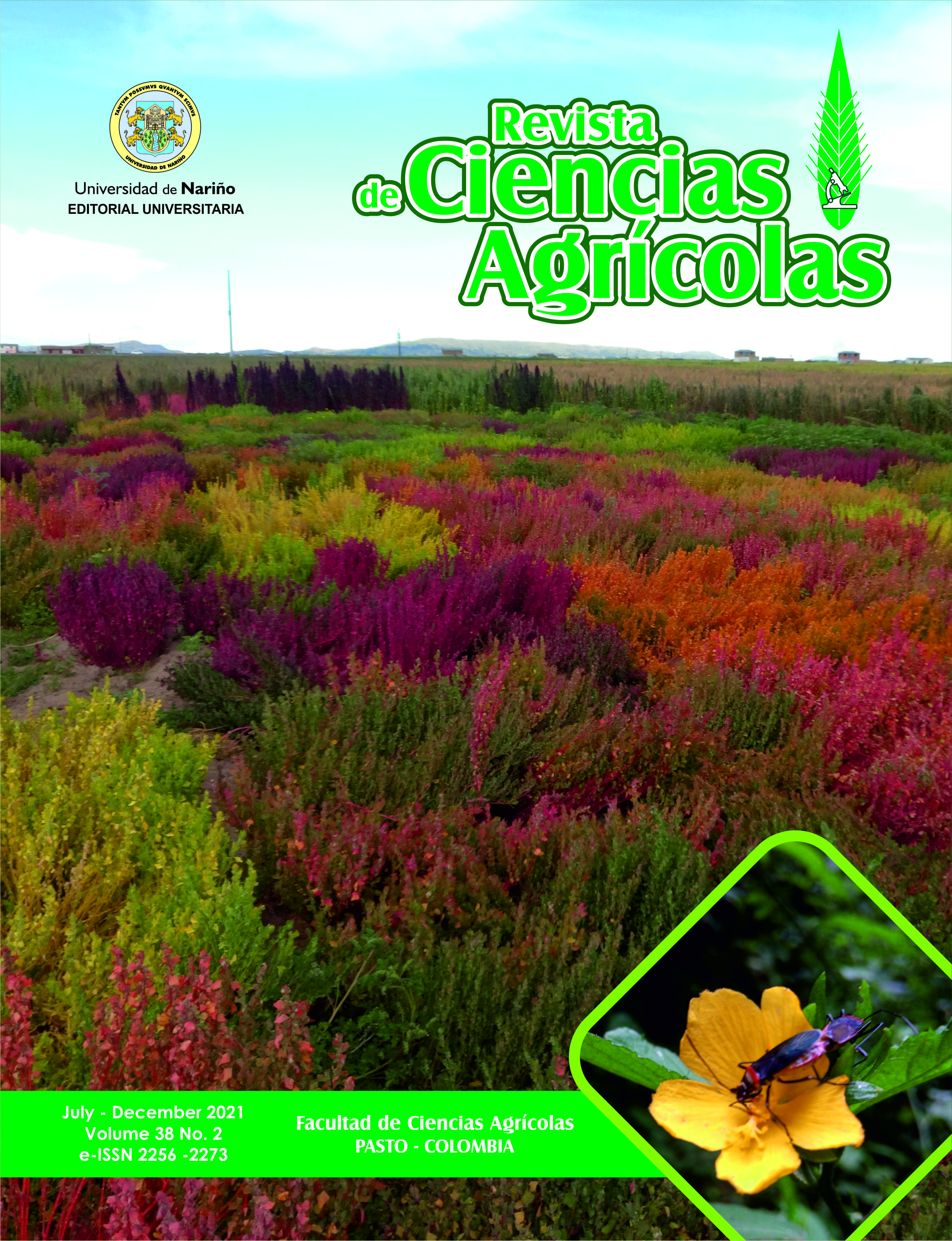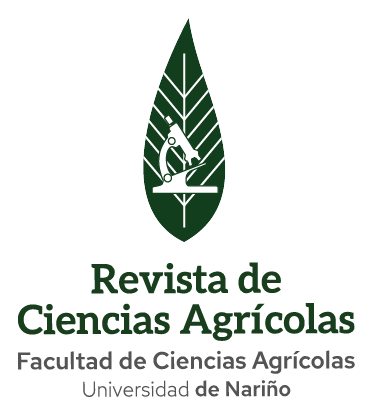Woody species associated with coffee production systems in southern Colombia
DOI:
https://doi.org/10.22267/rcia.213802.155Keywords:
Tree, biodiversity, wealth, similarity, somberAbstract
In the coffee zone of the town La Unión- Nariño, native or introduced trees are associated with the productive systems of the farms, mainly because they provide shade for coffee crops, where particular aspects such as species biodiversity and silvicultural management are unknown. With the aim of knowing the woody species of common use and the cultural importance, a semi structured survey was applied to 100 coffee growers who were selected at random and aleatorily distributed in three altitudinal ranges: (m.a.s.l.): I (<1500), II (1500-1800) and III (> 1800). Species richness was determined for each chosen range; for diversity between ranges, the Jaccard Index (JI) and the Cultural Importance Index (CI) were used. The latter was determined by adding up the intensity of use (IU), frequency of citation (FC), and use value (UV). In the three altitude ranges evaluated, 59 tree species were found. These were distributed in 32 botanical families and 46 genera. The fabaceae family was the most representative, followed by rutaceae, myrtaceae and bignoniaceae; 45.8% of the species were introduced. Among the altitudinal ranges, a low degree similarity was found; ranks I and II shared 24 species, which is equivalent to 33.8% of their floristic composition. As for ranges I and III, they had an even lower degree of similarity: 24.2%; only 17 species were shared. The species I. densiflora had the highest percentage of CI, with 32.92%, followed by C. sinensis with 31.98%; then the species T. gigantea and P. americana with 30.49% and 26.27% respectively. These species were of great importance to coffee growers due to the positive impact they have on the family economy and their contribution to the environmental well-being of production systems.
Downloads
Metrics
References
Alcaldía Municipal de La Unión. (2012). Plan de desarrollo municipal “La esperanza de un pueblo”. Nariño: Alcaldía Municipal de La Unión. 142p.
Cardona, A; Prado, Y.; Morales, S. (2013). Manejo de frutos y semillas de las especies forestales Inga densiflora Benth. e Inga edulis Mart. asociadas a paisajes cafeteros del departamento del Quindío. Revista de Investigaciones Universidad del Quindío. 24(2): 280-292.
Cardona, D; Sadeghian, S. (2005). Beneficios del sombrío de guamo en suelos cafeteros. Avances técnicos Cenicafé. 334:120- 178.
Comité de Cafeteros de Nariño - La Unión. (2018). Comité departamental de Nariño. Informe Comité Departamentales, documento técnico. 92-103. Nariño: Comité de Cafeteros de Nariño.
DaMatta, F.; Rodríguez, N. (2007). Producción sostenible de cafetales en sistemas agroforestales del Neotrópico: una visión agronómica y ecofisiológica. Agronomía Colombiana. 25(1): 113-123.
Da Silva, V.A; Andrade, L.D.H.C; De Albuquerque, U.P. (2006). Revising the Cultural Significance Index: the case of the Fulni-ô in Northeastern Brazil. Rev. Field Methods. 18(1): 98-108.
Escobar, H; Lagos, T; Bacca, T.; Muñoz, J. (2016). Caracterización de los sistemas productivos de café en Nariño, Colombia. Revista U.D.C.A Actualidad & Divulgación Científica. 19(1): 105-113
Farfán, F. (2012). Árboles con potencial para ser incorporados en sistemas agroforestales con café. Chinchiná: CENICAFÉ. 87 p.
Farfan, V; Jaramillo R. (2009). Sombrío para el cultivo del café según la nubosidad de la región. Avances Técnicos Cenicafé. 379:1-8.
Farfán, F.; Mestre, A. (2013). Manejo del sombrío y fertilización del café en la zona central colombiana. Avances Técnicos Cenicafé. 331.
Farfán, F; Baute, J.; Sánchez, P.; Menza, H. (2013). Guamo santafereño en sistemas agroforestales con café. Avances Técnicos Cenicafé. 396: 1-8.
FNC -Federación Nacional de Cafeteros de Colombia. (2018). Informe de gestión 2018, rentabilidad- legitimidad y resiliencia. Retrieved from https://federaciondecafeteros.org/app/uploads/2019/10/Informe_Gestion_2018_compressed-1.pdf
FNC - Federación Nacional de Cafeteros de Colombia. (2014). La política cafetera 2010 - 2014. Retrieved from https://www.federaciondecafeteros.org/static/files/1La_politica_cafetera_2010- 2014.pdf
FNC - Federación Nacional de Cafeteros de Colombia. (2020). Comportamiento de la industria cafetera colombiana 2020. Retrieved from https://www.federaciondecafeteros.org/static/files/Informe_Industria_2020.pdf
FHIA- Fundación Hondureña de Investigación Agrícola. (2004). Guía práctica: Producción de café con sombra de maderables. Retrieved from http://www.fhia.org.hn/dowloads/ cacao_pdfs/gpcafeconsombramaderables.pdf
Finol, H. (1971). Nuevos parámetros a considerar en el análisis estructural de las selvas vírgenes tropicales. Revista Forestal Venezolana. 14(21): 29-42.
Garen, E.J; Saltonstall, K; Slusser, J.L; Mathias, S; Ashton, M.S; Hall, J.S. (2009). An evaluation of farmers’ experiences planting native trees in rural Panama: implications for reforestation with native species in agricultural landscapes. Agroforestry Systems. 76(1): 219-236.
Garzón, H; Libreros, H. F. (1999). Productividad forrajera, pérdida de suelo y escorrentía superficial bajo bancos protéicos de madre de agua (Trichanthera gigantea), sólo y asociado con chachafruto (Erythrina edulis) y/o mani forrajero (Arachis pintoi) en la Martinica alta. Ibagué, Tolima, Colombia. Bogotá: AGROSAVIA.
Gómez, L; Caballero, A.; Baldión, J. (1991). Ecotopos cafeteros de Colombia. Bogotá: Federación Nacional de Cafeteros - FNC, 131 p.
MADR- Ministerio de Agricultura y Desarrollo Rural. (2017). Principales Cultivos por Área Sembrada en el Año 2014. Evaluaciones Agropecuarias Municipales. Retrieved from http://www.agronet.gov.co/Documents/Nari%C3%B1o.pdf.
Martínez, M; Evangelista, V; Basurto, F; Mendoza, M.; Cruz-Rivas, A. (2007). Flora útil de los cafetales en la Sierra Norte de Puebla, México. Revista mexicana de biodiversidad. 78(1): 15-40.
Martínez, F. (2004). El suelo y la producción de cafés especiales. Investigación en temas del café. La Unión, Nariño: Cooperativa de Caficultores del Norte. 10p.
Muñoz, S.; Villota, T. (2014). Evaluación de macrofauna y composición florística en sistemas productivos de café (Coffea arabica L.) en el municipio de La Unión, Nariño. Pasto: Universidad de Nariño.
Murray, R.; Larry, J. (2005). Estadística. 4 ta edición ed. México, DF: Mc Grawill.
Oberthür, T; Läderach, P; Posada, H; Fisher, M; Samper, L; Illera, J.; Jarvis, A. (2011). Regional relationships between inherent coffee quality and growing environment for denomination of origin labels in Nariño and Cauca, Colombia. Food policy. 36(6): 783-794.
Ordoñez, H. (2014). Estudio de la sustentabilidad de los sistemas de producción de café mediante indicadores, en el municipio de La Unión Nariño. Palmira, Colombia: Universidad Nacional de Colombia. 170p.
Paz, F; Torres, R. (2017). Estado Actual del Conocimiento del Ciclo del Carbono y sus Interacciones en México: Síntesis a 2017. Serie Síntesis Nacionales. Texcoco, Estado de México, México: Programa Mexicano del Carbono en colaboración con el Centro de Investigación Científica y de Educación Superior de Ensenada y la Universidad Autónoma de Baja California.
Ricaurte, L; Wantzen, K; Agudelo, E; Betancourt, B.; Jokela, J. (2014). Participatory rural appraisal of ecosystem services of wetlands in the Amazonian Piedmont of Colombia: elements for a sustainable management concept. Wetlands ecology and management. 22(4): 343-361.
Rice, R. (2008). Agricultural intensification within agroforestry: The case of coffee and wood products. Agriculture, Ecosystems and Environment. 128: 212-218.
Rice, R; Ward, J. (1997). El café, la conservación ambiental, y el comercio en el hemisferio occidental. Washington, DC: Centro de Aves Migratorias (SMBC) y Consejo para la Defensa de los Recursos Naturales (NRDC). 51p.
Saito, M. (2004). Sustainable coffee production. In: Wintgens, J.N. Coffee: growing, processing, sustainable production. pp.384 - 390. Weinheim: Wiley – UCH.
Salamanca, L. A. (2017). Evaluación de la producción de café bajo sombra con especies arbóreas en el municipio de pajarito. Retrieved from https://repository.unad.edu.co/handle/10596/13725?show=full
Sánchez, L; Durán, S; Vélez, J; García, R.; Botero, J. (2013). Estudios regionales de biodiversidad en las zonas cafeteras de Colombia. Cenicafé. 378: 1-8.
Sánchez, Y; Tapia, M.; Salazar, J. (2017). Importancia cultural de vegetación arbórea en sistemas ganaderos del municipio de San Vicente del Caguán, Colombia. Revista UDCA Actualidad & Divulgación Científica. 20(2): 393-401.
Sosa, L.; Escamilla, E.; Díaz, C. (2004). Organic coffee. In: Wintgens, J. Coffee: Growing, processing, sustainable production. A guidebook for growers, processors, traders and researchers. p. 339-354. Germany: WILEY‐VCH Verlag GmbH & Co. KGaA. doi: 10.1002/9783527619627
Tropicos. (2021). Missouri Botanical Garden. Retrieved from https://tropicos.org
Turner, N. (1988). The importance of a rose. Evaluating the cultural significance of plants in Thompson and Lilloet Interior Salish. American Anthropologist. 90(2): 272-290.
Universidad Nacional de Colombia. (2020). Scientific Collections OnLine. Biovirtual. Retrieved from http://www.biovirtual.unal.edu.co
Vargas, L; Suárez, J; Pantoja, C. (2012). Conocimiento local de los servicios ecosistémicos en arreglos agroforestales de café (Coffea arabica L.) del sur de Colombia. Ingenierías & Amazonia. 5(1): 17-29.
Villavicencio, L.; Valdez, J. (2003). Análisis de la estructura arbórea del sistema agroforestal rusticano de café en san miguel, Veracruz, México. Revista Agrociencia. 37(4): 413-423.
Zapata, P. (2019). Composición y estructura del dosel de sombra en sistemas agroforestales con café de tres municipios de Cundinamarca, Colombia. Ciencia Forestal. 29(2): 685-697.
Published
How to Cite
Issue
Section
License
Copyright (c) 2021 Revista de Ciencias Agrícolas

This work is licensed under a Creative Commons Attribution-NonCommercial 4.0 International License.




























